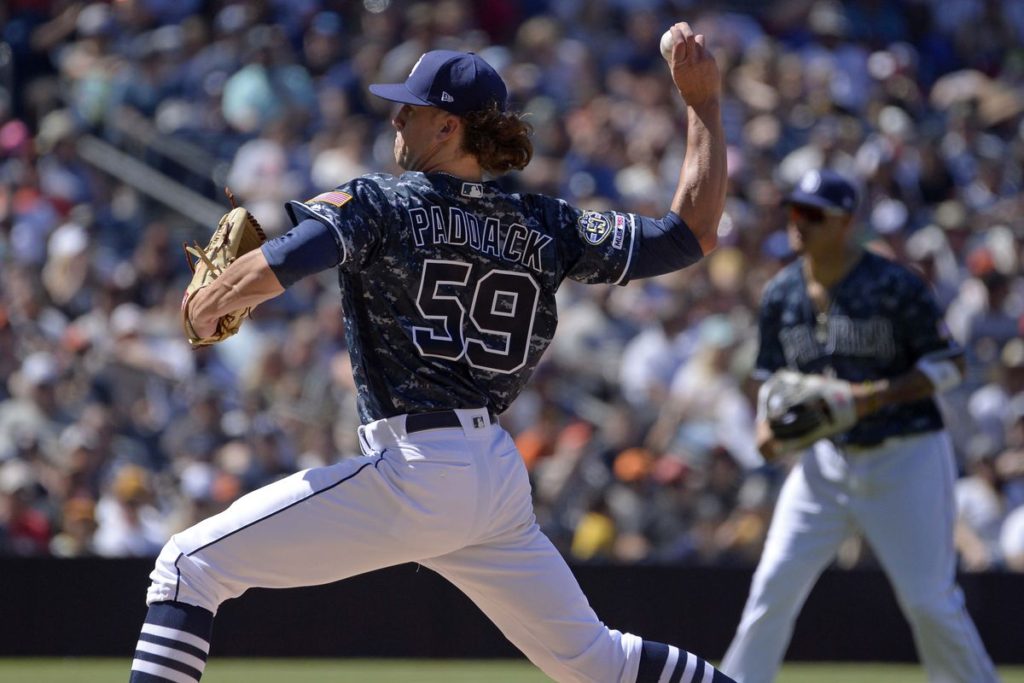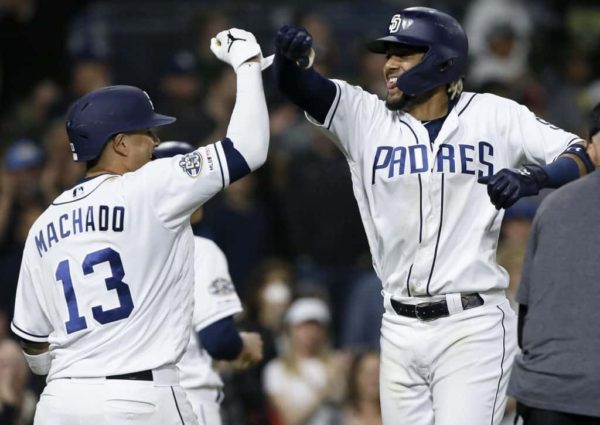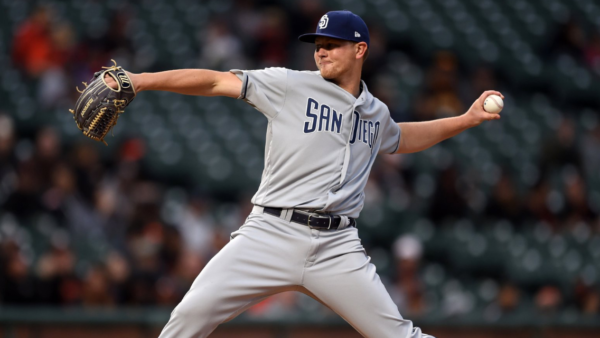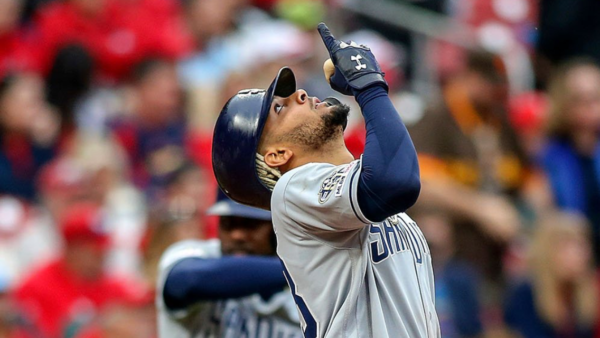Early Padres Trends & Statistics That Probably Won’t Last

Credit: USA Today

The San Diego Padres are off to a very hot start in 2019. Here is a look at some early trends and statistics that probably won’t last.
There are certain things that can be discerned after just 16 games of Padres baseball.
Manny Machado is the best player the San Diego Padres have had in quite some time. Fernando Tatis, Jr. is pretty talented. Hunter Renfroe has some power. Those sorts of things.
However, there’s other trends and statistics that take a tad longer than two weeks to level out. So, let’s take a look at some of them that immediately stand out and examine why they most likely won’t last.
*As a note, all statistics are as of 4/12.
Manny Machado’s strikeouts
All things considered, Machado has had a very impressive start to his Padres career. Every opportunity at third base has been played flawlessly. He’s been an on-base machine. Everyone in the clubhouse seems to gravitate towards him and he’s embraced the energy of his new, young ballclub. He’s even shown some hustle on the basepaths to the surprise of many pundits around the league.
The one trend that’s been a bit concerning, however, is the strikeouts. He’s already punched out 15 times in 62 plate appearances, a 24 percent clip. The first and most obvious reason to believe that this trend won’t continue is the fact that his career high in that department is just 19 percent, set in 2014. Last year, that number was 15 percent. Throughout his career, and especially in the more recent past, being a high strikeout guy just hasn’t been part of his game, so there really is no reason to believe that will change now in his age-26 season.
Second, he’s seen the highest percentage of curveballs in his entire career (11.4 percent), which has historically been the pitch he’s struggled with most. Somewhat intertwined with the curveball stat has been the early struggles of Franmil Reyes hitting behind him in the lineup. More on Reyes’ struggles (or perhaps lack thereof) in a moment, but there’s no denying the .176/.268/.412 slash line. Once Reyes, or whoever hits behind Machado, starts to produce, Machado will surely get more pitches he can handle.
Starting rotation’s ERA
It’s no secret that the starting rotation was the main concern about the 2019 Padres going into the season. The dominant narrative was that the young offense should be explosive, the bullpen should be solid if not exceptional, the defense should be passable, but that rotation…that rotation could be rough. So far, that has not been the case. The rotation of two second-year guys and three first-time Major League starters has been the most effective position group by a significant margin, posting an NL West-best 3.02 ERA.

It’s entirely possible that the rotation will be better than expected for the entirety of 2019. The breakout seemingly out of nowhere by Nick Margevicius could validate that statement alone. Chris Paddack should only get better as he continues to settle in at the big-league level, and Joey Lucchesi and Eric Lauer both have the chance to establish themselves as legitimate top-of-the-rotation arms on what should be a good team. To expect the team starter-ERA to remain steady, however, would require a heavy dose of delusion. A return to the NL-worst 5.09 mark the group posted in 2018 probably won’t happen, but neither will a plateau anywhere near 3.02. Expecting something in between seems reasonable.
Franmil Reyes’ bad luck
A quick look at the box scores through two weeks would indicate that Franmil Reyes is off to a dreadful start. And production-wise, yes, that is correct. But surface-level stats often don’t tell the whole story, no case of that being more relevant than that of Reyes. According to Baseball Savant, Reyes is currently in the 95th percentile in all of Major League Baseball in average exit velocity, 80th percentile in hard-hit percentage and 97th percentile in expected batting average. That last number, expected batting average, is calculated by Baseball Savant based on the quality of contact that a player makes. Reyes’ current batting average is .176, while his expected batting average is .349. That makes him, statistically, the single unluckiest hitter in the league so far this year.
But guess what? The stats don’t stop there. When compared to his breakthrough 2018 season in which he slashed .280/.340/.498 and hit 16 homers in only 285 plate appearances, he’s actually been better in 2019. Strikeout percentage: 17.1 percent this year compared to 28.1 percent last year. Walk percentage: 12.2 percent this year compared to 8.4 percent last year. Exit velocity: 94.9 MPH this year compared to 92.3 MPH last year. Barrel percentage: 20.7 percent this year compared to 11.6 percent last year. There’s more, but the point should be clear by now — Reyes has been swinging the bat as well as he ever has in his young career, and it’s only a matter of time before his fortune takes a turn.
Chris Paddack’s walks
This paragraph will be short and sweet, because, well, Paddack only has three starts and 14 innings worth of sample size to work with. He’s walked six, four of them coming on April 6, when the free pass was ultimately what chased him from the game after just 3.2 frames. He’s sporting a 3.86 BB/9 right now. His previous high at any level of professional baseball was 1.93. Last year it was 0.80. The strike zone doesn’t change once you get to the big leagues, so it isn’t much of a stretch to see this being a blip on the radar.
Ian Kinsler leading off
Andy Green doesn’t have a sure-fire leadoff option on the roster at the moment, so this is not to suggest that the Kinsler experiment at the top of the lineup was done in error. However, after two weeks, it’s clear that Kinsler is not the answer in that spot moving forward. Luis Urías, who has struggled mightily since being recalled, and Manuel Margot have both gotten a crack at leading off, and conventional wisdom would suggest that they are the two most viable options to occupy that spot moving forward.

Fernando Tatis, Jr. would also make some sense with his speed and explosiveness, but Green seems determined to let him get his feet under him a bit longer towards the bottom of the lineup before adding the pressure of hitting near the top of the order. At this point in his career, Kinsler is best served in a backup/utility role, and with Urías back with the big boys, it seems like that should be the case moving forward. Margot, although not drawing many walks, is off to a good start and appears to be the odds-on favorite to take over the role.
Trade Rumors involving the Cleveland Indians
Despite the excellent start, the starting rotation is still a significant question mark. Dating back months into the offseason, there have been constant rumors swirling regarding a possible Indians-Padres trade. On paper, it almost makes too much sense. Cleveland has the deepest and most talented rotation in Major League Baseball, but an outfield that resembles that of a 100-loss team. The Padres have a rotation that also somewhat resembles a 100-loss team, but find themselves with an overflow of outfielders who all need consistent at-bats.
Those rumors are probably dead for the foreseeable future. Mike Clevinger, who tossed 200 innings of 3.02 ERA ball in 2018, recently landed on the injured list with a terres major muscle strain in his upper back. Cleveland manager Terry Francona said on Tuesday that “it’s probably going to be six-to-eight weeks before we’re even looking at him picking up a ball.” The Indians deciding to further thin the rotation through a trade right after losing one of their most integral pieces seems very unlikely.
The other factor working against a possible Indians-Padres deal has been Trevor Bauer’s otherworldly start to 2019. Through his first 14 innings of work, he gave up a grand total of one hit. Bauer had previously been the hottest name in the world of Padres-related trade rumors, but he has looked every bit the part of a future, if not current, superstar, and may have priced himself out of the Padres range in the process.
Born and raised in San Diego, CA. Currently living in Eugene, OR as a junior at the University of Oregon. Journalism major, Padre fan, music lover. Attended my first Padre game at the Q in 1998 when I was three months old. Follow me on Twitter: @BradyLim619.
It may help to remind you that Hosmer is known for being an early season slow starter, it’s to early to be concerned with the way anyone is hitting
Very good article, Brady. You keyed in on some interesting areas/stats. One area of concern is how the starters struggle to go deeper into games, which then taxes the bullpen. I’m not sure how much longer they can sustain this (I don’t know if you have any stats for that?). Connected to this, it seems some of the starters have great difficulty putting some hitters away. In other words, there has been at least a few times where a hitter fouled off several pitches, which drove up the pitch count, which then led to an early exit for the starter (I’m thinking specifically of Paddock in St Louis).
Another thing to keep an eye on is Hosmer and how the Padres handle this. I doubt they have the fortitude to sit him when they should do just that. They should at least do this against lefties.
Some stats regarding the bullpen (over)usage…
-The only team in the league that has more IP from the bullpen in an equal or less amount of games is the Orioles, and the Orioles are obviously not very good
-The average start length for SPs so far is 4.92 innings. I don’t have those numbers for the whole league to compare, but I do know that that number is way too low. That’s not sustainable, especially without key pieces from the bullpen last year (Castillo, Strahm, Hand for a good part of the year)
As for Hosmer, he’s not going to be platooned. You could certainly argue that it would be beneficial, but it’s just not going to happen.
The Padres certainly have a vested interest in Hosmer working out, if only due to the idiotic contract. But at the very least Andy Green needs to pull his head out of his ass and stop batting Hosmer 2nd or 3rd. He should be batting 6th or 7th.
As for them not platooning him, don’t be too sure about that.
Your recipe for benching or platooning him:
1) The club is still in contention in 2 months.
2) Hosmer is still killing worms and rallies.
3) There’s an internal option, such as Naylor raking at AAA, or both Renfroe and Reyes hitting allowing Myers to move to 1B.
Long term you always want a player to succeed, but if he doesn’t/can’t/won’t then you trade him, and the leverage to do that is his playing time.
Thanks! That is helpful.
Also, I agree, sadly, that no matter how bad it gets, he won’t be platooned. However, it would otherwise go without saying: a team should play its best players. Who knows, the Padres have made a few surprising moves.